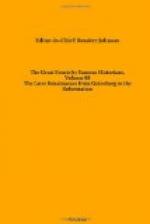[Footnote 1: On August 18, 1503, he and his father drank, by mistake, a poison which they had presumably prepared for one of their guests. The father died, and Borgia’s life was for a time in extreme danger.]
[Footnote:2 Within thirteen months he lost all his sovereignties, and was imprisoned, but escaped to Spain, where he was killed in the attack on Viana in 1507.]
PAINTING OF THE SISTINE CHAPEL
THE SPLENDOR OF RENAISSANCE ART UNDER MICHELANGELO
A.D. 1508
CHARLES CLEMENT
In the history of the Renaissance the revival of art adds a new glory to that of letters, and among the masters of that revival there is none greater than Michelangelo Buonarroti, sculptor, painter, architect, poet, and heroic man. He was descended from an ancient but not distinguished Florentine family, and was born at Caprese, Italy, March 6, 1475. In 1488 he was apprenticed to the painter Ghirlandajo. He studied antique marbles in the garden of San Marco, where he was discovered by Lorenzo de’ Medici, who in 1489 took him into his palace. There the young student remained until his patron’s death (1492), improving the great opportunities presented to him. The Mask of a Faun was sculptured during this time.
Before the expulsion of the Medici he went to Bologna, and there executed several works. Returning to Florence in 1495, he was called next year to Rome, where he lived till 1501, producing works which displayed his extraordinary genius, the most important of them being the Pieta di San Pietro (1498). Again returning to Florence, he carved his first David from an immense block of Carrara marble. In 1505 he was summoned again to Rome, by Pope Julius II, to design his tomb, and this work occupied Michelangelo, from time to time, throughout the remainder of his life. He was forced—probably through the intrigues of Bramante, his rival in architecture—to leave Rome, and once more (1506) returned to Florence. In the intervals between all these dates he produced many of his masterpieces.
From this period the historian follows Michelangelo through an important stage of his active career, showing how “the hand that rounded Peter’s dome,” and created so many other of the greatest works of art, toiled on with patient heroism, in spite of hinderances almost incredible. The painting of the Sistine Chapel, upon which his fame so largely rests, is here described in language that reveals the manhood no less clearly than the artistic genius of Michelangelo.




